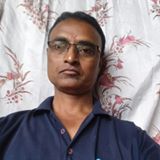What exactly is pilonidal sinus (PNS)?
Pilonidal is a combined expression of pilus means
hair and other is nidus stands for nest. So pilonidal sinus means sinus with
nest of hair.
This is an acquired condition, and mostly occurs in young male adults (hairy men) than in women.
A pilonidal sinus can be an infected tract, a
tiny abnormal narrow tunnel / a tube like random shaped structure in the body under your skin between the
buttocks (the natal cleft) which commonly contains hair.
The sinus track goes
into a vertical way between your buttocks. The most frequent site for the PNS is over the
sacrum in the gluteal cleft, and usually contains hair, dirt, and debris and
the tract may release pus. It could cause discomfort, embarrassment, severe
pain, and could become contaminated, and infected. If it becomes afflicted, it
could ooze pus, and blood and also have a
foul odour. Additionally it is called as
‘Jeep-Bottom’ because this is quite common in Jeep drivers.
Also Read
Gout is your worst enemy. How to defeat Gout with Ayurveda ?
Symptoms of pilonidal sinus -
The symptoms of pilonidal sinus are the following -
Pain/sore, swelling, and redness at the base of the
spine.
External sinus starting seen at the bottom of
spine (painful, small red opening in the area of the cleft of the buttocks).
Draining pus - pus oozing right out the cyst/discharge from the sinus is blood stained, foul smelling, and possesses hairs.
Low back ache due to swelling of the cyst.
Fever.
History of abscess on lower back.
Hair protruding from the lesion, development of
more than one sinus tract in the skin, and
chronic or continuing sinus in the midline,
between buttocks.
Factors behind pilonidal sinus -
The exact cause is not yet determined. Most
instances occur in young adults (over the age of 40) and uncommon in children and women.
It really is much more common in excessive hairy men.
Certain factors raise the risk of growing the condition, and include -
Long term sitting jobs like driving a vehicle,
computer jobs etc.
Obesity
(over - weight), and over sweating problem.
A previous persistent soreness or injury to the
afflicted area.
Possessing a hairy, deep/profound natal cleft
and twisting of hairs below skin leading to contamination, and infection to hair
root.
Improper sitting style, poor hygeinic condition
or insufficient sanitation of sacral region and family history of the condition.
AYURVEDA TREATMENT
A simple and straightforward treatment described
in a surgical text book – Sushruta-Samhita. Maharishi Sushruta has advocated a
minimally invasive para-surgical treatment, Kshar Sutra method, for naadi vrana (a track which is
because of presence of pus, fibrosed unhealthy tissue, and hair etc.). The condition is discussed as Naadeevrana in Sushruta- samhita
and treatment is named Kshara-sutra therapy which helps effective curettage, and
drainage facilitates healing without recurrence. This treatment not only
minimizes complications, and recurrence but also enables the individual to
resume their daily routine work as soon as possible.
Advantages of kshar sutra -
Kshar
Sutra is a medicated thread coated with
natural alkaline ayurvedic herbs like latex Euphorbia nerifolia, and kshar of
certain herbs like repeated coatings of latex -Snuhikshara- Sehund or Thuhar
(Euphorbia lingularia), ash of Achyranthus aspera (Apamarga-kshara),
Arkakshara(Caltropis gigantea) and natural antibiotic like haridra - turmeric (Curcuma longa) powder in a specific order, and can be cured completely
without surgery.
No anesthesia, No hospitalization, No pain, No need
of bed rest, No need of surgery, No tissue loss, No ulcer or wound, No foul
smell, No wound dressing, No recurrence, Only 15 - 20 minute’s procedure, OPD method, Cost -
effective treatment, can do almost any
work after treatment, minimum rates of
complication, minimally invasive method, good potential in the management of
Pilonidal sinus, low recovery time (duration of treatment is 4 to 8 weeks), high success rate, patient can continue his/her routine work
within 1 - 2 days and you can avoid surgery by this natural way.
---------------------------------------------
WRITTEN BY RAJESH KUMAR
---------------------------------------------
WRITTEN BY RAJESH KUMAR
Recommended Posts for you













No comments:
Post a Comment